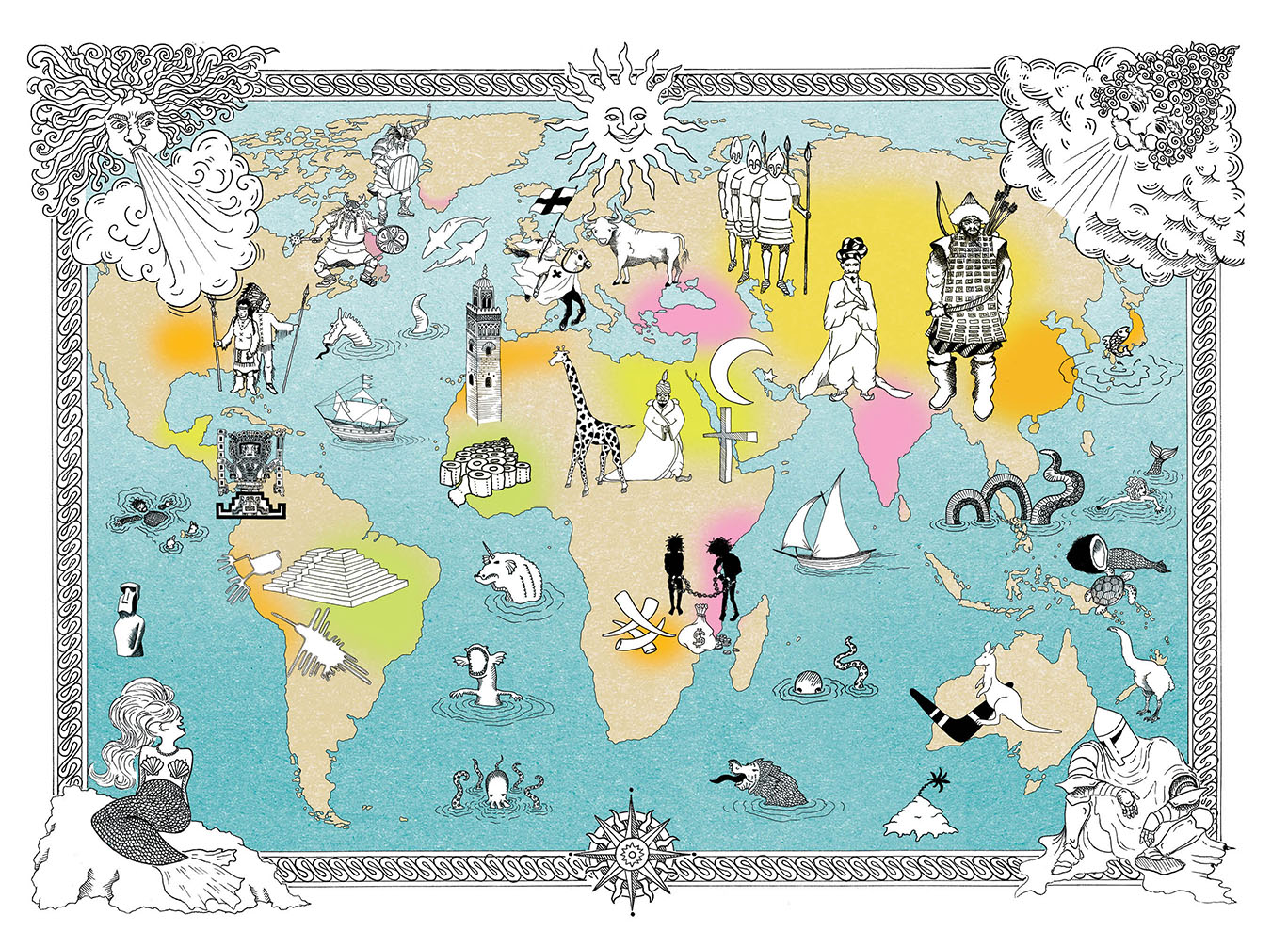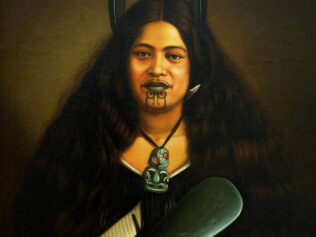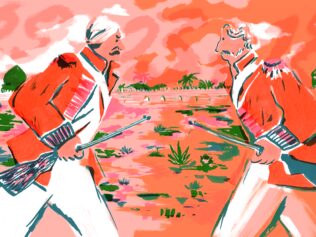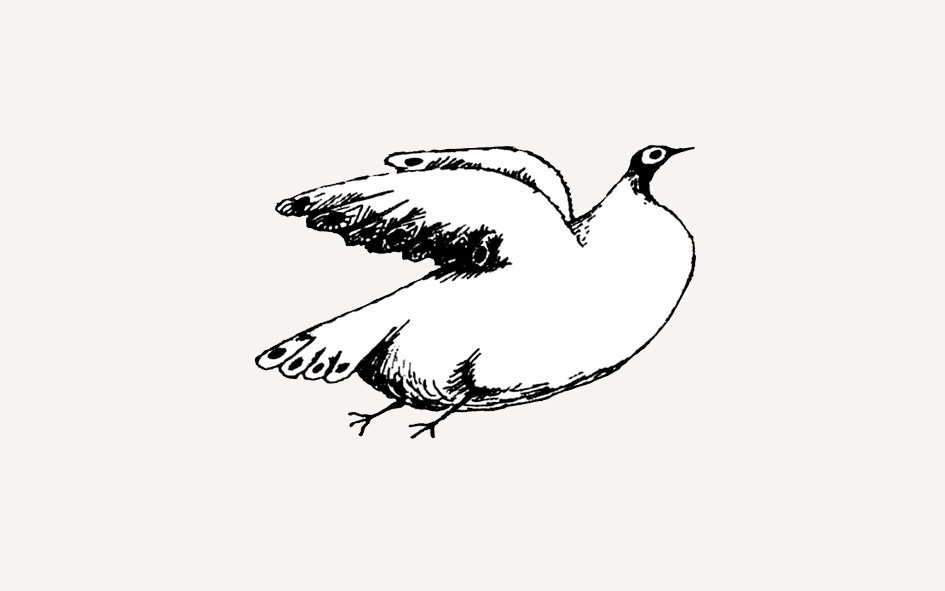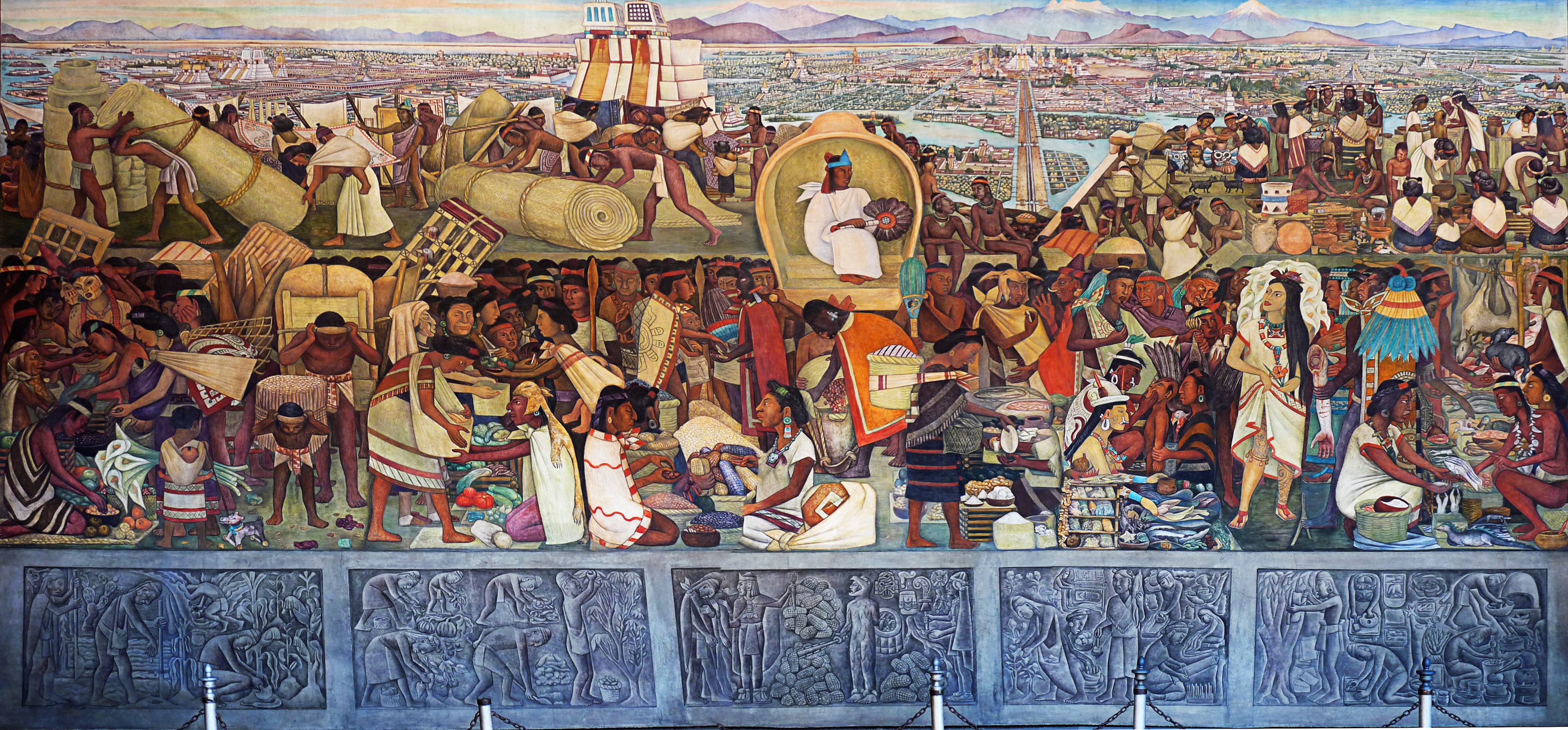
Two African travelers meet on a pilgrimage in medieval Mecca—one has just returned from Australia, and the other will soon set out to search for the land we now call America. Impossible? Not at all. It’s just hard for Europeans to imagine.
The West is not the center of the world— this is a truth its adherents are increasingly having to confront today. The emergence of Europe as a major global power was not a historical inevitability, but the result of random events. It is enough to go back a few centuries to see a globe on which the western-most stretch of the Eurasian continent was nothing more than one of many significant spots on the map, and certainly not the most important, the richest, nor the most influential. This is the Earth in the year 1313.
One Thousand and One Kingdoms
In the 14th century, no one considered migrating from Africa to Europe in search of a better life. Leaders of African empires were more interested in conquering their neighbors north of the Mediterranean Sea than moving in with them. In Muslim Morocco, for example, the Marinid Sultanate was planning to expand into the Iberian Peninsula. After all, the place had been under Islamic rule for a good few hundred years, and the Emirate of Granada, with its impressive wealth, was still fighting back Christian armies.
Yet, at the meeting point of both civilizations, trade and culture also flourished. It was an intellectual hub for brilliant physicians, mathematicians, and architects. The breathtaking minaret of the Mosque of the Booksellers [Kutubiyya] towered over the Moroccan city of Marrakesh. Meanwhile, the adolescent Ibn Battuta was already fantasizing about faraway journeys to the furthest parts of the known world. Soon, his dream would come true: over the next quarter of a century, he would travel a distance of 74,500 miles across Africa, Asia, and Europe.
Morocco neighbored with the even more powerful Muslim state of Mamluks who controlled Egypt, part of Libya, and vast swathes of the Middle East. The sultans were ruthless to their enemies and generous toward the sprawling sanctuaries in Mecca and Medina. The inhabitants of this harshly-ruled empire could find some relief in the One Thousand and One Nights—a collection of centuries-old folk tales of money, sex, and power. These stories were so popular and so inappropriate that they became the target of Islamic censors and religious leaders in the 14th century.
The world of great politics wasn’t limited to the north of Africa. In 1313, the Muslim Kanem Empire was already flourishing around Lake Chad. Its tens of thousands of warriors fought against the local tribes. However, the sultan was also diplomatic, sending giraffes as gifts to friendly rulers. It should also be noted that Kanem was not a come-and-go kind of state—according to historians, it lasted from the eighth to the late-14th century, after which it continued as the Bornu Empire until the year 1900.
Meanwhile, on the east coast of Africa, Christian Abyssinia—today’s Ethiopia—stood proud of its thousand-year Christian tradition, still resisting Islamic expansion. However, its geography separated Ethiopia from other Christian countries to such an extent that in the Middle Ages, Europeans believed it to be the semi-legendary Kingdom of Prester John (as mentioned in Umberto Eco’s Baudolino). Contrary to Western medieval fantasies, there were no dog-headed people, no giants nor cyclopes in this part of Africa. Instead, there was something else—the impressive rock-hewn churches in Lalibela. These wonders were to turn the Ethiopian city into a new Jerusalem, replacing the original one now occupied by Muslims. Builders from India and the Middle East were said to have worked on the construction of the temples. They were carved into rock to make them harder for enemies to spot and destroy.
Meanwhile, Arab merchants arrived near Ethiopia, traveling across the corner of Africa and toward the south of the continent. The Swahili civilization developed from the 10th century onwards by dealing in gold, ivory, and slaves. It soon became a trading power, with the city of Kilwa at its center. Founded in today’s Tanzania by a Persian prince in 1313, it became the seat of the sultanate.
Among the states trading with Kilwa was one even further down south: the Kingdom of Zimbabwe, the capital of its Southern African rulers being Great Zimbabwe. When British colonizers saw the city’s ruins in the Victorian era, they refused to believe it was the work of local peoples. It gave rise to various theories that Great Zimbabwe was an ancient Phoenician colony, a site of King Solomon’s mines, or the property of the Queen of Sheba. Meanwhile, it was not an ancient city but a medieval one. In 1313, Great Zimbabwe was still prosperous and home to between 10,000 and 18,000 people.
If everything looked so promising, then why did so many of these civilizations fail to survive or develop, like the European ones? The answer is very simple: Africa is not Europe. “The vast spaces and difficult natural conditions were not conducive to dynamic growth, making it impossible to efficiently travel across the continent,” explains historian Łukasz Burkiewicz from Jesuit University Ignatianum in Kraków. “In Europe, it was different. The free migration of people brought with it the possibility of transporting not only goods, but also technological ideas. Unfortunately, in Africa, it was not as simple.”
And still, at least one African country in the 14th century could have changed the world forever—Mali. One wonders what would have happened if the Atlantic expedition of its king had succeeded.
The Richest in History
In the 14th century, the Muslim empire of Mali was a developed West African state that lived off the trade of precious metals, as well as caravans moving through the Sahara. “All major trade routes ran through Mali, going from Arab-controlled North Africa down south, to the center of the continent,” explains Burkiewicz. “The peak of the country’s power came in the first half of the 14th century, during the rule of Mansa Musa. Not only did he conquer the neighboring states like Songhai, but he also supported economic development. Musa himself was a remarkably wealthy monarch who owned numerous salt and gold mines.”
In a 21st-century ranking made by the Celebrity Net Worth website, Mansa Musa was listed as the richest man of all time. His fortune was estimated to be equal in value to 400 billion dollars. With such capital today, he could afford to build three hundred Burj Khalifa skyscrapers—the tallest in the world. Or, as one joker calculated, he could get 40,000 solid-gold toilet rolls. It’s not surprising to learn that during his journey to Mecca through Cairo, Mansa Musa and his entourage spent so much gold that they caused a financial crisis in Mamluk Egypt.
Education in Mali thrived, along with the University of Sankoré (as proven by the famous manuscripts of Timbuktu). Malians were also probably familiar with the achievements and instruments of Arab sailors, such as the astrolabe. Mansa Musa assumed the throne in 1312 after his brother Abu Bakr II, who funded two expeditions to the West, wanting to explore “the limits of the ocean.” On the first, 200 ships set out and one returned, with its crew lamenting the great river on the other side, and the eddy that had wiped out the rest of the fleet. And so for the next voyage, Abu Bakr II prepared 2,000 ships instead. He set sail for the Atlantic in 1311 and never came back.
Had Abu Bakr II reached the New World—or had Mansa Musa carried on with his brother’s legacy instead of spending a fortune on his enormous pilgrimage to Mecca—Mali could have colonized it by 1313. After all, the sultans of Mali had almost unlimited financial resources. They controlled four hundred cities, twenty million people, and an army of 100,000 soldiers.
An American Interregnum
Imagine if Malian sailors had landed on the Brazilian coast of the pre-Columbian Americas in 1313. They would have found a network of settlements—garden-cities of sorts. Moving southwest, they could have seen the crumbling but still monumental stone city of Tiwanaku by the shores of Lake Titicaca. At the Sechura desert, they might have been amazed by glimpses of the mysterious geoglyphs of the Nazca Lines, already several hundred years old.
Traveling in the opposite direction, to the north, the newcomers would reach Cuzco, the capital of the little Incan state. I say “little,” for it was not yet the empire it would become, shortly before the arrival of the Spanish conquistadors. In 1313, the Incas were just one of many Andean tribes, the most influential being the Chimú. Best-known for Chan Chan—the largest pre-Columbian city in South America—the culture is easily recognizable because of the enchanting animal patterns on the adobe walls of its buildings. Built from these sun-dried clay bricks, the dense urban center stretched over an area that covered nearly 116 square miles, housing over twenty-thousand people. That’s more than the population of Kraków or London at the time, and comparable to Rome (although less than the 100,000-strong population of Constantinople).
It’s interesting that the Andean peoples rather didn’t seem to consider the exploration and occupation of unknown lands, though they had ships good enough to try. “Offshore sailing was in operation. Indigenous people sailed on reed boats with a curved bow and stern, or on flat balsa wood rafts capable of carrying multi-ton loads, and reaching as far as the Galápagos archipelago, or even Easter Island,” explains Jarosław Molenda, traveler and author of several history books. “Depictions of such boats appear frequently on the Moche ceramics from the turn of the era. Despite having the means, it seems the rulers of these pre-Columbian empires didn’t feel the need for conquest. Indeed, many lacked the labor force for working the fields. They had enough land, so why search for more, far beyond the horizon?”
African civilizations living close to the Sahara did not have a problem with surplus fertile land, quite the contrary. That’s why a new continent would have been an appealing prospect. Hacking their way through lush Central America, the Malians would have encountered the already declining Mayan civilization—grass-covered ruins among which a number of small warring states still existed. Further north, the Aztecs (or Mexica, as they called themselves) were just emerging. Their capital city of Tenochtitlán—inhabited by nearly a quarter of a million people during the times of the conquistadors—was not to be established until 1325. Thus, the hypothetical African conquerors would have been met with little resistance.
Meanwhile, the situation deep inside pre-Columbian North America might seem surprising, where cities existed alongside nomadic Indigenous tribes. They were mainly the vast farming settlements of the Mississippian civilization, shadowed by towering earthen platform mounds up to ninety-eight feet tall—the largest being in Cahokia, Illinois. The Cliff Palace, built by the Anasazi peoples in today’s Mesa Verde, Colorado, is also staggeringly impressive. However, they would not have rivaled the Malian conquerors. Anasazi experienced prolonged drought, and in Mississippian territory—floods. Cahokia, once inhabited by at least twenty thousand people, was experiencing depopulation. The Anasazi Cliff Palace was also becoming deserted.
“Indeed, at that time in the Americas there was a prevailing period of ‘interregnum,’ and the moment of conquest would have been ideal,” admits Jarosław Molenda. However, both he and Łukasz Burkiewicz believe it would have been difficult for Malian explorers to conquer America, even if they had reached it and settled there. These African sailors could very well have shared the fate of the other “forgotten” discoverers of America—the Vikings.
Unrealized Potential
In 1313, a Viking settlement—known to today’s scientists as Point Rosee—still existed in Newfoundland. Not far out, there was another, older one: L’Anse aux Meadows. It’s a wonder how Vikings arrived on the Canadian island. They came from Greenland, which, back in the Middle Ages, was much more habitable than it is now. The Norse seafarers built their settlements and churches on the icy island—up until the 15th century, they were still getting married in the Hvalsey Church, whose ruins survive to this day. When the climate began to cool around 1300—during the so-called Little Ice Age—the Vikings began to look for friendlier terrain. However, these journeys into the unknown were both grueling and dangerous, and many a Viking ended as a Greenland shark’s meal.
But back to the tale of the living Vikings. By sailing further west, they reached Newfoundland and settled there. As it turned out, however, it was not for them to be the New World’s conquerors. There were simply too few Vikings. As for the Malian explorers, there might have been more of them, but in being accustomed to their wealth at the time, it’s debatable whether they would want to sacrifice their lives to conquer an unknown land. Nonetheless, in 1313, it was not yet out of the question that the America of the future would speak Old Norse or Arabic. Or maybe even a combination of these languages, were both Viking and Malian colonization successful. Who knows, perhaps there would even be a clash between Christianity and Islam.
At the time, the influence of the Islamic world reached as far as the Antipodes: coins from pre-1400 Kilwa were found on Marchinbar Island, near the northern edge of Australia. It is most likely that merchants from the African sultanate made their way there, a staggering distance of almost 5,000 miles. Were they not limited to trade but had also founded a sultanate, they might have written over time of Aboriginal Australians, boomerangs, kangaroos. It’s also likely that they would have traveled to the distant—and seemingly deserted—Pacific Ocean.
In fact, this remote part of the world was full of activity in the year 1313. Polynesian boats were traveling across Oceania. The Maori people had just arrived in New Zealand and, in search of meat, had started to slaughter moa, the enormous eleven-foot tall flightless birds. Meanwhile, on Easter Island, the Rapa Nui were erecting their first monumental statues. And on the island of Pohnpei in Micronesia, the city of Nan Madol—sometimes described as the megalithic “Venice of the Pacific”—was thriving. Megalithic, because it was built with colossal basalt blocks. Venice, due to its location, over a hundred artificial islands separated by navigable canals. The diet of its inhabitants consisted mainly of coconuts, fish, and turtles they kept in farmed ponds.
Had broadcast news existed in 1313, one might assume that non-European world domination was not only achievable, but even imminent. If any of these civilizations were to colonize the so-called New World, the year 1313 might have been a symbol of historical bad luck for Europeans (after all, it is the superstitiously portentous number thirteen repeated twice). But, as fate would have it, the Americas and Antipodes were conquered by travelers from the Old Continent—hardly a lucky outcome for the Indigenous peoples.
Lentils, Wheels, and Rolling Mills
Meanwhile, in Central Europe, there was no Poland to speak of—the kingdom was in a state of district dismemberment. For the past few years, the titular king of Poland was John the Blind—King of Bohemia and Count of Luxembourg—who aspired to be an emperor. At the same time, Duke Ladislaus the Short, who dreamt of uniting the Piast dynasty lands of Greater and Lesser Poland, had a lot on his plate. He had just suppressed Mayor Albert’s rebellion (1311–1312) by the privileged burghers of Kraków, many of whom were of German origin. In order to identify the rebels, Ladislaus supposedly gave an order to kill everyone unable to pronounce the words soczewica, koło, miele młyn [lentils, wheels, and rolling mills]. He felt so unsafe during the bourgeois revolt that Ladislaus decided to move his residence to Biecz, giving this lovely town unceasing bragging rights as the “capital of Poland” for less than a year.
Poland in 1313 was a divided, marginal country on the edge of Europe. With no universities, it was regarded as backward in comparison to the West. The future natural monument of the great Bartek Oak was yet to germinate in a quarter of a century. There was no lack of primeval forests with the mighty long-horned aurochs [an extinct species of wild ox] roaming the woodlands, while in the cities there wasn’t a single visionary to match the genius of Italy’s Dante (who was working on The Divine Comedy at that very moment) or Giotto (busy painting his frescoes in the chapels of Santa Croce) in Florence. The one great scientific mind of the Silesian Vitello—a friar, physicist, mathematician, and creator of the foundations of what would later become visual perception psychology—is not enough to compare the development of Polish science with that of England, home to Grosseteste and Bacon in the 13th and Ockham in the 14th centuries.
Anno Domini 1313 saw Poland consumed by internal conflict and threatened by its neighbors at the same time. The subjects of the Piast dominion still remembered the invasions of Lithuanians, Prussians, Ruthenians, and Mongols. They were tormented by the Margraviate of Brandenburg and the Teutonic Order. The latter knights were summoned by the citizens of Gdańsk to curb the appetite of the former Holy Roman Margraves. Yet it ended with the city’s slaughter. The German crusaders were only growing in strength and feathering their nest, having just moved into their newly-built castle in Malbork.
Conflicted and Hungry
The influence of the Teutonic Knights expanded, while the reputation of their older and wealthier counterparts—the Knights Templar—declined. The greedy and cynical king Phillip the Fair of France was plotting to have the Templars accused of heresy. The order was dissolved, its property seized and its resisters were burned at the stake. And all that time, Philip was supported by the French-dependent Avignon pope.
The end of the Templars, sealed by the execution of the order’s last Grand Master Jacques de Molay in 1314, meant the enormous crusade they had planned would never take place. In the Holy Land, Christian influence was becoming a thing of the past, as it was ruled by the Mamluk Sultanate. Meanwhile, the Turkish tribes in Anatolia were setting up a state of their own, soon to become another Islamic Ottoman empire that would threaten the weakened Byzantine Empire first, and then the whole of Western Europe.
The Ghāzī warriors were not the only military threat coming from the East. Another was the Mongols who, at the time, still consisted of many different faiths (shamanism, Buddhism, Christian Nestorianism, Islam) and were interested only in conquest. At Europe’s eastern frontier, Ruthenian states were terrorized by Mongols from the so-called Golden Horde (commonly known as the Tatars). The Grand Duchy of Moscow—later to be a powerful player in the region—was still in its infancy. Egyptian Mamluks also trembled before the Mongol khans. And so, several European leaders dreamed of converting all Mongols to Christianity.
Luckily for the peoples under threat of conquest, the Mongols fractured into several khanates and quarreled. But in 1313, ambitious Mongol leaders were still hoping for unification. Back then, nobody could face up to these warriors—nomadic, resilient, and cheap to maintain—especially since they had access to such Chinese inventions as gunpowder and battle gas. In Asia, Gengis Khan’s descendants could have conquered the highly-populated and wealthy Delhi Sultanate that controlled most of India. It would have also been possible for them to take over the declining Khmer Empire in Cambodia. And while its capital city of Angkor had a population of one million—which, in the 13th century, made it the largest city in the world—such numbers were not enough to impress the Mongols. In 1300, China alone had some sixty million people living under their rule, and twice as many in the rest of the subjugated territories. Together, that made up one-quarter of the planet’s population—more than in all of Europe at the time.
A Palace Roofed with Fine Gold
In 1313, the Old Continent was nothing more than a peninsula between Asia and Africa. Europe was yet to conquer new lands overseas. These future colonial powers had other problems. The English had just managed to quell the rebellion of the Scots led by William Wallace (made famous by Mel Gibson’s Braveheart). French coffers were empty while at loggerheads with England, which would soon result in the Hundred Years’ War (from 1337). The Spanish were busy recapturing the Iberian Peninsula from the Muslims. Europe could barely feed itself with contemporary farming methods in 1313. Just a few years later, its population would decline due to crop failures, and it would only be four decades (from 1346) before it would drop drastically due to the Black Death plague.
However, the European imagination was already being stirred by tales of Marco Polo’s travels. Around 1274, the brave Venetian had arrived at the court of Kublai, Mongol Khan and Emperor of China. Polo also brought news of the distant land of India back to Europe, as well as Japan (Chipangu), which the Mongols had twice failed to conquer in 1274 and 1281. “[It] is an island towards the east in the high seas,” said Marco Polo, repeating what he had heard of Japan from sailors and traders. “The people are white, civilized, and well-favored. They are Idolaters, and are dependent on nobody.” Most importantly, Chipangu was very rich. “The quantity of gold they have is endless […] they also have pearls in abundance, which are of a rose color, but fine, big, and round.” The King’s palace was “entirely roofed with fine gold,” its floors and pavement also “entirely of gold, in plates like slabs of stone, a good two fingers thick.”
Even if it was mostly fantasy, Marco Polo opened his eyes to the world: its immensity and wealth. In a way, he made it clear to Christian Europe that it was but a fragment of a multi-faceted planet. It was India and the Chipangu of precisely Polo’s tales that Christopher Columbus hoped to reach when he embarked on the historic voyage that would lead to the colonization of the New World—and to making Europe powerful beyond belief.
Translated from the Polish by Aga Zano
This translation was re-edited for context and accuracy on November 17, 2022.


